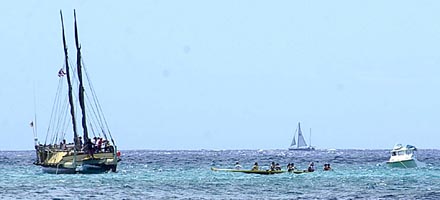 |
| The Hokule'a left waters off Waikiki yesterday for the first leg of a two-island voyage, with stops at Kaua'i and Nihoa.
Rebecca Breyer • The Honolulu Advertiser
|
By Jan TenBruggencate
Advertiser Kaua'i Bureau
The voyaging Hokule'a left anchor off Waikiki shortly after 2 p.m. yesterday, headed for Kaua'i.
The canoe is on the first leg of a trip along ancient voyaging routes, to include a visit to Nihoa — an island once inhabited by Hawaiians, but now left to birds and sea creatures. It is part of the Hawaiian Islands National Wildlife Refuge.
Hokule'a was to anchor at Hanalei Bay at about midday today.
Most of its 13-member crew for the Kaua'i voyage was to be replaced today by an 18-member crew for the Nihoa trip. The canoe is expected back at Kaua'i this coming weekend.
 |
| "We're staying in Hawaiian waters, but we're going to an island I've never been to before and the canoe had never been to before," Bruce Blankenfeld said.
Advertiser library photo |
Crew member Boyd Yap of Pearl City said the canoe helps preserve Hawaiian culture and tradition.
"This is how we got here," Yap said.
Blankenfeld said a voyage to Nihoa is still a trip of discovery.
"We're staying in Hawaiian waters, but we're going to an island I've never been to before and the canoe had never been to before," he said.
Nihoa was well known to Hawaiians at the time Capt. James Cook visited in 1778, and was still visited seasonally by canoes from Ni'ihau during the 1800s, but canoe visits had stopped by 1900. Today, many Hawai'i residents don't know it exists.
The voyaging canoe will carry, in addition to a cadre of experienced Hokule'a sailors, a group of cultural practitioners who will spend the night on Nihoa and perform ceremonies designed to re-establish the traditional link between the island and the Hawaiian people — a connection that was lost when Hawaiians stopped voyaging there.
Nihoa is a cultural and biological treasure — a small volcanic island covered with ancient house terraces, temples and agricultural sites, and containing what biologists say is one of the least damaged dry lowland ecosystems in all of Hawai'i.
Hokule'a's weeklong voyage is a precursor to one set for May, in which the canoe is expected to sail through the 1,200 miles of the Northwestern Hawaiian Islands to Kure Atoll, the northwesternmost island in the Hawaiian archipelago.
A combination of circumstances, among them Hurricane Jimena and a broken mast on an escort vessel, forced the Polynesian Voyaging Society to put off its planned voyage to those islands this month. But with the canoe ready to sail, a crew trained and the cultural group eager to go, the society decided to make a limited voyage, with a visit to the first of the Northwestern Hawaiian Islands.
 |
| "There are things that are special in our world, things that we care deeply about, and these things we definitely need to save," Nainoa Thompson said.
Advertiser library photo |
Thompson also hopes the voyage will help boost the Polynesian Voyaging Society's new mission, which it calls "Navigating Change," which takes the society's primary direction from wayfinding and voyaging to education.
Great educational tool
Hawai'i educators say the canoe is a powerful catalyst for engaging Hawai'i kids of all backgrounds. The combination of the canoe and Thompson, the first Hawaiian non-instrument navigator in generations, makes a powerful image for many students.
"I've seen them respond to Nainoa," said Punahou School President Jim Scott. "I've seen Nainoa Thompson at work with some of our kids ... there is this metaphor of wayfinding and their finding their own way ... I think it's a pretty brilliant educational message."
And once kids respond, the canoe and its crew can be used to teach astronomy, navigation, oceanography, culture, shipbuilding, ocean biology and more, said Randy Hitz, dean of University of Hawai'i's College of Education.
"The Hokule'a: The kids know about that. It's something that interests them, something they can identify with, and there's an awful lot of learning that can take place around that vessel," Hitz said.
Ku Kahakalau, head of the Kanu O Ka 'Aina charter school in Waimea, Hawai'i, said her school has little contact with Hokule'a, but students have sailed on the voyaging canoe Makali'i.
"A lot of Hawaiian kids get to know a lot about their heritage, and it gives them a real sense of pride. Also, the teamwork that happens when you go out on the ocean, the collaboration and partnership, are valuable skills," Kahakalau said.
Hokule'a was launched in 1975. The double-hulled canoe is made of modern materials but designed to perform like the voyaging canoes of ancient Polynesia. It has employed non-instrument navigational techniques to visit the most distant corners of Polynesia and many of the islands between.
Saving what's important
Thompson said its mission now is to work within the Hawaiian Islands — to encourage children to learn, and to promote an environmental ethic among all Hawai'i residents.
"There are things that are special in our world, things that we care deeply about, and these things we definitely need to save," he said.
Advertiser writer Jan TenBruggencate is sailing aboard Hokule'a, sending dispatches along the way. When he returns, you can reach him at (808) 245-3074 or at jant@honoluluadvertiser.com.
© COPYRIGHT 2003 The Honolulu Advertiser, a division of Gannett Co. Inc.
Original article URL: http://the.honoluluadvertiser.com/article/2003/Sep/08/ln/ln13a.html/?print=on